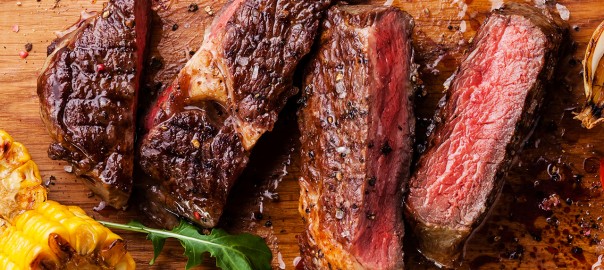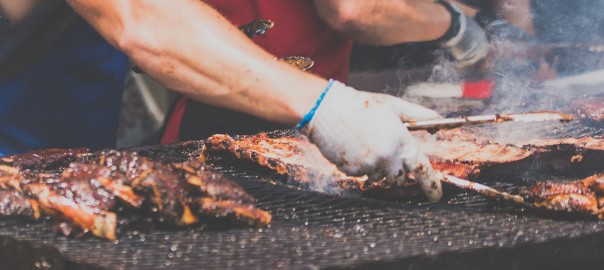Meaty, beefy, juicy — steak is an American classic.
With so many varieties and cuts of steak, though, it can be hard to know what sets each cut apart. What’s the difference between top sirloin steak, for example, and NY strip steak? Why are ribeyes and porterhouses so widely regarded in the culinary world? What’s the difference between skirt steak and flank steak, and how do you slice those thinner cuts?
This guide demystifies the world of steak and gives you the knowledge and tools to expertly prepare any kind of steak at home. From Philly cheese steaks whipped up with shaved steak to a decadent sauce-doused filet mignon, you’ll know exactly what you’re doing when preparing either.
ButcherBox members receive many of these steaks in their monthly box. If you would like to sign up to get grass-fed, grass-finished beef delivered to your door, click here.
Top Sirloin Steak
Cut close to the round primal section of the cow, top sirloin steak is incredibly versatile. It’s rich like a roast but shares the texture and mouthfeel of a steak. You can grill it up to be served on its own or cube it and add it to stews and soups. It’s an economical cut of steak, making it great for everyday meals. Give this jerk-rubbed top sirloin with mofongo a try for a hearty, spicy meal.
Steak Tips
Incredibly tender, premium steak tips can be cut from tri-tip, coulotte, and sirloin. More pedestrian cuts come from various muscles but need a bit more help to be made into tender and juicy meals. They’re robust and meaty, and, at roughly one-inch a square, they make for some delicious hunks of meat. Try these braised in a soup or stew, or as full-flavored kebabs like this Dijon garlic smoked sirloin kebab dish.
Skirt, Bavette, and Flank Steak
Both skirt steak and flank steak are long, flat, and flavorful, while bavette steak is finely textured and flat. True bavette steak is hard meat cut to find in the U.S., despite its popularity across the pond. Flank steak is taken from the flank primal and is generally cut whole, and not divided into smaller portions. Skirt steak packs an even beefier flavor than flank steak, due to its connective tissue and fat content. Skirt steak is the default choice for fajitas, while flank steak responds well to marinating and grilling. Make sure to slice both thinly against the grain. For a good flank steak recipe, give this cilantro lime hickory grilled flank steak a try.
Shaved Steak
Looking to whip up a Philly cheese steak or a stir fry? Shaved steak is the ideal cut. Trimmed from the rib section, shaved steak is tender and full-flavored. It’s quick on the stove due to its thinness and pairs well with robust marinades.
New York Strip Steak
A favorite of steakhouses the world over, the New York strip steak can be cut thin or thick. It’s well-marbled and extremely tender, as it’s cut from the short loin, a rarely used muscle on the cow. The strip steak is a cut of beef that requires little more than a simple seasoning and a solid technique. Grill it, pan-sear it, or roast it—whatever you do, use lots of butter or even garlic butter. Enjoy this coffee-rubbed New York strip steak with berry sauce and parsnip mash for a well-rounded meal.
Ribeye Steak
The ribeye is a ButcherBox member favorite. Cut from the center of the rib section, it is smooth, rich, super beefy, and has significant marbling. Ribeyes respond well to an open flame due to their healthy fat content. Char them lightly and cook them until medium-rare. Here is a simple, sultry pan-seared ribeye recipe.
Ranch Steak
Ranch steaks are very lean—they’re trimmed of virtually all fat and cut from the shoulder muscle. They possess a distinct earthy flavor, in case you needed a reminder that they are indeed grass-fed. Due to the lack of fat, this steak can become tough if overcooked, so it’s best to aim for medium-rare. If you’re in the mood for something different, enjoy the caramelized and salty flavor of these honey and sea salt ranch steaks with rainbow carrots.
Denver Steak
While the term Denver steak has only been applied to this cut in recent years, a similar steak is called the zabuton by the Japanese due to its similarity to a plush seating cushion. It’s extraordinarily marbled and tender, coming from the same muscle section as the ribeye. It responds well to Asian flavors, like in this miso Denver steak recipe.
Filet Mignon
Famously fancy, filet mignon is a buttery, tender cut of beef. They come from the center of the tenderloin and are silky smooth in texture and mild in flavor. Grass-fed cattle are unique in that they produce filets with rich marbling and depth. Given their mild flavor, filet mignons hold up to decadent sauces like cream sauces or balsamic glazes. Date night? Here is the perfect filet mignon meal for two.
Flat Iron Steak
Flat iron steak comes from an area of the cow that is notorious for its tough, sinewy texture. However, researchers discovered a way to access the most tender section for a lean steak with rich marbling. Cut from the shoulder, it’s got a deep, meaty flavor and cooks up quick. Try it with a full-bodied sauce like a red wine glaze. Here’s a tasty pepper crusted flat iron with root vegetable mash.
Porterhouse
The king of T-bones, a porterhouse is actually two steaks in one, consisting of a large NY strip on one side, and a filet mignon on the other. Fun fact: The tenderloin portion must be at least 1 ¼ inches thick to earn its namesake. Given its thickness, a porterhouse should be seasoned liberally, producing a thick crust of kosher salt and fresh ground pepper. Here’s a recipe for the perfect porterhouse steak with herb butter.





